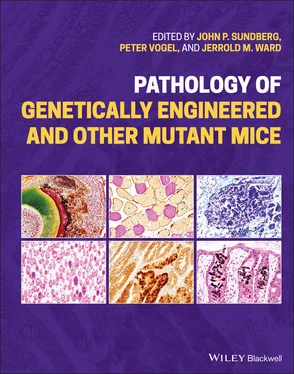Pathology of Genetically Engineered and Other Mutant Mice
Здесь есть возможность читать онлайн «Pathology of Genetically Engineered and Other Mutant Mice» — ознакомительный отрывок электронной книги совершенно бесплатно, а после прочтения отрывка купить полную версию. В некоторых случаях можно слушать аудио, скачать через торрент в формате fb2 и присутствует краткое содержание. Жанр: unrecognised, на английском языке. Описание произведения, (предисловие) а так же отзывы посетителей доступны на портале библиотеки ЛибКат.
- Название:Pathology of Genetically Engineered and Other Mutant Mice
- Автор:
- Жанр:
- Год:неизвестен
- ISBN:нет данных
- Рейтинг книги:3 / 5. Голосов: 1
-
Избранное:Добавить в избранное
- Отзывы:
-
Ваша оценка:
- 60
- 1
- 2
- 3
- 4
- 5
Pathology of Genetically Engineered and Other Mutant Mice: краткое содержание, описание и аннотация
Предлагаем к чтению аннотацию, описание, краткое содержание или предисловие (зависит от того, что написал сам автор книги «Pathology of Genetically Engineered and Other Mutant Mice»). Если вы не нашли необходимую информацию о книге — напишите в комментариях, мы постараемся отыскать её.
An updated and comprehensive reference to pathology in every organ system in genetically modified mice Pathology of Genetically Engineered and Other Mutant Mice
Pathology of Genetically Engineered and Other Mutant Mice
Pathology of Genetically Engineered and Other Mutant Mice — читать онлайн ознакомительный отрывок
Ниже представлен текст книги, разбитый по страницам. Система сохранения места последней прочитанной страницы, позволяет с удобством читать онлайн бесплатно книгу «Pathology of Genetically Engineered and Other Mutant Mice», без необходимости каждый раз заново искать на чём Вы остановились. Поставьте закладку, и сможете в любой момент перейти на страницу, на которой закончили чтение.
Интервал:
Закладка:
Fzt:DU provides a better example of an outbred stock [33]. This population was generated by crossing four other outbred stocks and four disparate inbred strains together to produce eight founder populations of 15 litters and then a careful breeding rotation was followed to maximize the allele frequencies in the population.
Various breeding strategies have been reported in the literature for maintaining maximal genetic diversity in an outbred stock and all require a large population with a set rotation of breeding interactions. Random breeding places selective pressures on the population, most notably for a preference of increased fecundity, but has been used in some outbred stocks, and sibling breeding must be avoided. The nomenclature for outbred stocks begins with the laboratory code of the researcher who bred it followed by a colon followed by upper case stock name of two to four letters representing the population. Some outbred populations have been generated around a particular mutation in order to assess that phenotype in a diverse genetic setting. J:NU is an outbred stock bred around the nude ( Foxn1 nu) mutation. Crl:SKH1‐ Hr hris an outbred stock commonly used for UV light carcinogenesis studies because they have a high frequency for developing aggressive squamous cell carcinomas compared to other inbred strains carrying the hairless mutation [23]. The nomenclature (Crl:SKH1‐ Hr hr) again reflects the breeder (Crl), outbred strain (SKH1), and the specific allelic mutation Hr hr.
Diversity Outbred (DO) Mice
While there is genetic diversity in the outbred stocks described above, over time the genetic diversity will decrease without a very large colony maintained by a careful breeding scheme to avoid inbreeding. In addition, because each mouse is unique, there are no relevant control animals or sequenced reference genomes. These factors present significant difficulties in using outbred stocks. To address these issues and further expand genetic diversity, another approach was taken in recent years. As described above, the Collaborative Cross strains were developed using a mix of eight inbred strains that represented the most genetic diversity possible with existing inbred strains at the time. In the process of producing these mice, an alternative approach was developed in which 144 partially inbred Collaborative Cross strains, at generations ranging from F4 to F12, were maintained by randomized outcrossing, to create a novel population of mice, the Diversity Outbred stock, in which each individual mouse had an equal amount of DNA from all the progenitor strains, but all in a unique mix [34]. Each mouse is phenotypically and genetically different from the next and resulting in a huge variation in phenotypes. Large SNP genotyping arrays make it possible to phenotype large numbers of these mice that share the same phenotype and identify the candidate genes that might cause the problem [35–37].
Nomenclature for the Diversity Outbred stocks follows that of outbred stocks, J:DO, where J is the breeder, The Jackson Laboratory in this example, and DO stands for Diversity Outbred.
Nomenclature for Normal and Mutated Genes
Spontaneous mutations, including sequence variants, copy number variants, small indels, and multigenic chromosomal aberrations constantly arise in colonies but at relatively low rates so they are often missed unless a careful screening program is in place to identify them. This is called genetic drift and can be a major problem for large production colonies. There is also the real potential problem of genetic contamination, where strains are inadvertently mixed. To minimize and control these problems, two approaches are used in large production colonies: the Genetic Stability Program (GSP) ( Methods for maintaining genetic stability of inbred animal strains ( https://www.jax.org/jax‐mice‐and‐services/find‐and‐order‐jax‐mice/why‐jax‐mice/patented‐genetic‐stability‐program) US 7592501 [22 September 2009]; SG 119769; CN 200480023858.4 [23 June 2010]; AU [11 November 2010]; US 8110721 [7 February 2012]; JP 5072359 [31 August 2012]; USA 8552254 [8 September 2013]) and a genetic quality control program [37]. GSP essentially resets the genetic drift back to an arbitrary start point every ~5 generations by the use of a large pool of inbred embryos to replace the Founder stock. Genetic quality control programs regularly screen breeders at the top and sample the bottom of the production chain for a variety of molecular markers (SNPs) and phenotypes [38]. Newer methods, built around SNPs, utilize MiniMUGA Genotyping Arrays [38]. Prior to polymerase chain reaction (PCR), a variety of diagnostic screens (enzyme assays) and tail skin grafts were used ( https://resources.jax.org/misc/jax‐handbook‐genetically‐standardized‐mice).
Spontaneous mutations can be recessive, semi‐dominant, or dominant and can be true nulls, hypomorphic alleles, or gain‐of‐function mutations. Some result from retrovirus integration events, such as the hairless allele ( Hr hr) discussed above [39]. Radiation and chemical mutagenesis are also used to create mutations in mice without targeting specific genes, although specific phenotypes may be the focus. Genetically engineered mice can be created by transgenesis, recombineering, or nuclease mediated approaches. While many engineered mutations are called knockouts, not all are true nulls so this term has to be used carefully.
Spontaneous Mutations in Mice
Spontaneous mutations have traditionally been named for the readily observable phenotype(s) they initially present. In the pre‐genomic era chromosomes were defined in large part by the linkage maps of phenotypic mutants. The gene(s) impacted by a spontaneous mutation are not initially known, and the symbol for such a heritable phenotypic marker is italicized and all lower case for recessive mutations, such as bg for beige, ob for obese, and d for dilute. The first letter of the symbol is in upper case for dominant or semi‐dominant mutations, such as Tr for trembler. When the impacted gene is identified, if the mutation is a molecular lesion in only one gene, then the original marker symbol becomes a superscript of that gene for the allele symbol, Lyst bg, Lep ob, Myo5a d, and Pmp22 Tr, respectively. Although gene symbols may change over time as the function and ontology of the gene is better understood, other than becoming a superscript of the gene, the allele symbol remains the same as does the allele name. For example the commonly used nude mouse gene name has changed considerably over time ( Table 3.11). For mice, the gene symbol has the first letter capitalized and subsequent letters in lower case, all in italics. Hyphens are avoided except to depict new alleles of the initial phenotypic mutation ( Table 3.12). For example, while interleukin 10 is commonly written in journals as IL‐10, the correct gene symbol would be Il10 and protein symbol would be IL10. Human gene symbols are essentially the same as for mice except the human gene symbols are all in capital letters and italicized. Greek letters are not used at all, only Roman letters and Arabic numbers. For example, interferon gamma is Ifng . The protein coded for by this gene is listed in capital letters with no italics (IFNG) for both mouse and human proteins.
Non‐engineered Induced Mutations
The system for naming chemically or radiation‐induced mutations is similar to that for spontaneous mutations, except that while many are initially assigned phenotypic names and corresponding symbols, some are instead assigned program accession numbers. One example of this is nmf12 , which was the 12th characterized ENU induced mutation in the neuroscience mutagenesis facility (nmf) at The Jackson Laboratory. Once the underlying mutation was found to be a H716R point substitution in the gene MER proto‐oncogene tyrosine kinase, the symbol changed to Mertk nmf12[40].
Читать дальшеИнтервал:
Закладка:
Похожие книги на «Pathology of Genetically Engineered and Other Mutant Mice»
Представляем Вашему вниманию похожие книги на «Pathology of Genetically Engineered and Other Mutant Mice» списком для выбора. Мы отобрали схожую по названию и смыслу литературу в надежде предоставить читателям больше вариантов отыскать новые, интересные, ещё непрочитанные произведения.
Обсуждение, отзывы о книге «Pathology of Genetically Engineered and Other Mutant Mice» и просто собственные мнения читателей. Оставьте ваши комментарии, напишите, что Вы думаете о произведении, его смысле или главных героях. Укажите что конкретно понравилось, а что нет, и почему Вы так считаете.












